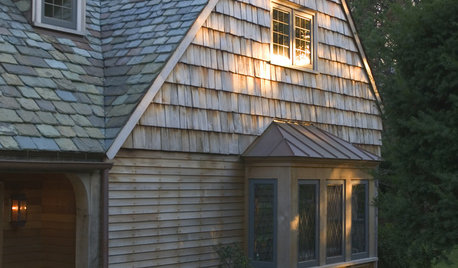Asbestos Shingles
msjay2u
11 years ago
Related Stories

EXTERIORS5 Easy Tips for Choosing Your Exterior Paint Palette
Make your home the talk of the neighborhood — in a good way — with an exterior paint scheme that pops
Full Story
REMODELING GUIDESSeal the Deal With Fiber Cement Siding
Chameleon-like, durable and low maintenance, fiber cement gives home exteriors of all shapes and styles a winning edge
Full Story
HOUZZ TOURSHouzz Tour: A Radical Reconstruction Raises an Austin Home
With a new second floor and some room swapping downstairs, this 1935 Texas bungalow now fits an architect and his family beautifully
Full Story
EDIBLE GARDENSLessons From an Edible Garden on a City Roof
Reincarnation of New York City rooftop pool proves edible landscaping is possible just about anywhere
Full Story
REMODELING GUIDESFiber Cement Siding Takes a Front Seat
Not just a wood or vinyl substitute, fiber cement is a stellar siding choice in its own right for modern home exteriors
Full Story
CURB APPEALHow to Update a Traditional Exterior With Color
Keep those historic architectural details — a few gallons of paint may be all you need to give a traditional facade a stylish new twist
Full Story
EXTERIORSRoofing Materials: Slate Makes for Fireproof Roofs That Last
It stands up to weather and fire without losing its high-end look. But can your budget handle it?
Full Story
REMODELING GUIDESThe Hidden Problems in Old Houses
Before snatching up an old home, get to know what you’re in for by understanding the potential horrors that lurk below the surface
Full Story
EDIBLE GARDENSA Formerly Weedy Lot Now Brims With Edibles and Honeybees
Photographers transform their barren backyard into an oasis filled with fruit, vegetables, honey, eggs and more
Full Story
HOUZZ TVHouzz TV: Fun Family Living in 980 Square Feet
In a place known for going big, a family of 4 opts for creative space savers and subtle luxuries instead
Full Story









brickeyee
msjay2uOriginal Author
Related Professionals
Clute Kitchen & Bathroom Designers · Hybla Valley Kitchen & Bathroom Designers · Lafayette Kitchen & Bathroom Designers · New Castle Kitchen & Bathroom Designers · Northbrook Kitchen & Bathroom Designers · Philadelphia Kitchen & Bathroom Designers · Wesley Chapel Kitchen & Bathroom Designers · Brentwood Kitchen & Bathroom Remodelers · Chicago Ridge Kitchen & Bathroom Remodelers · Galena Park Kitchen & Bathroom Remodelers · Ogden Kitchen & Bathroom Remodelers · South Barrington Kitchen & Bathroom Remodelers · Warren Kitchen & Bathroom Remodelers · Holtsville Architects & Building Designers · Martinsville Architects & Building Designersbrickeyee
msjay2uOriginal Author
brickeyee
azzalea
msjay2uOriginal Author
msjay2uOriginal Author
brickeyee